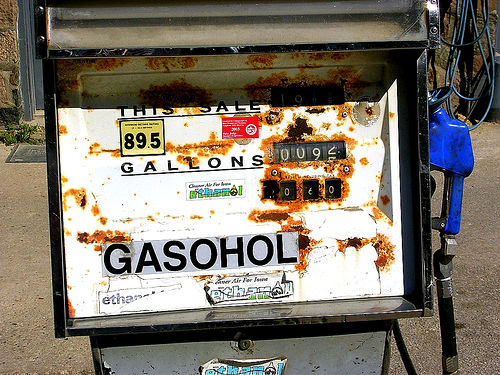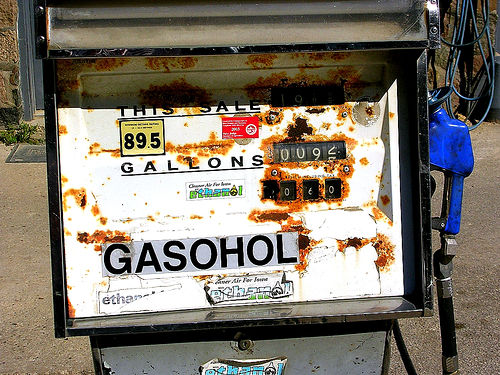I’ve been writing for a while now about problems with distillers grains, the leftover mash from the corn-ethanol process.
A third of the corn that goes into ethanol winds up as distillers grains. Finding a high-value use for this “coproduct” is absolutely vital to the corn ethanol project. The fuel’s energy balance is paltry — that is, it delivers little net energy compared to how much is consumed producing it. Even the studies that credit the fuel with a positive energy balance, like this one from the USDA, acknowledge that it’s pretty much a wash unless you give generous energy credits to distiller’s grains.
Of course, the “coproduct” has found its use as animal feed — as a replacement for corn in the rations of livestock in confined animal feedlot operations (CAFOs). One of the many supreme ironies of corn-based ethanol as “green” fuel is that it relies on the existence of CAFOs, one of the most ecologically damaging industrial processes in the United States. As ethanol production boomed starting in 2007, borne up by new “renewable fuel” mandates, distillers grains flowed into cow feedlots.
The industry issued reports about the miraculous quality of distillers grains as cow feed — and pushed to get the industrially processed mash into poultry and pig rations as well. The ethanol-factory-to-feedlot flow continued, even as evidence began to arise that the sudden spike in distillers grains use might have been contributing to a nasty spate of E. Coli 0157 in beef — evidence that the USDA has willfully ignored.
Now comes information that has trickled out before (I wrote about it here): the ethanol process relies on copious doses of antibiotics to control the fermentation process — and distillers grains carry heavy traces of them into feedlot rations.
Associated Press reports that the FDA has tested distillers grains samples and found them to contain significant levels of antibiotics. “Ethanol producers use penicillin and a popular antibiotic called virginiamycin,” AP reports.
One thing that comes to mind is the whole antibiotic-resistance issue. Are ethanol plants cooking up antibiotic-resistant bacteria? Turns out they may well be. The AP article quotes a University of Minnesota researcher who “found some bacteria that were, in fact, resistant when he sampled bacteria at four Midwest ethanol plants several years ago.” Classic — evidence that a major industrial process might be cooking up a public-health disaster emerged “several years ago,” and U.S. public health authorities sit on their hands.
Then there’s the question of antibiotic traces turning up in livestock feed. Here’s AP:
“A year ago we put a survey out to the FDA field people to collect samples of those distillers grains, and start analyzing for antibiotic residues,” said Linda Benjamin, a chemist with the FDA’s Center of Veterinary Medicine. Samples were requested from 60 ethanol plants, including some in Minnesota. She said testing showed that many contained antibiotics, mainly four types. “Penicillin, virginiamycin, erythromycin and tylosin,” said Benjamin.
Then we get this priceless bit: “At this point the story gets murky. Benjamin won’t say if any of the antibiotics exceeded federal guidelines.” Right — an FDA official wouldn’t want to go around informing the public of a potential hazard!
Not that federal antibiotics guidelines are much of a help. “Those guidelines are part of the problem; they’re a patchwork and far from definitive on what levels of antibiotics in distillers grain are safe,” the AP reporter states.
The FDA vows to keep studying the issue, but will face tremendous pressure to sit on its hands — in essence, to favor a government-darling industry over public health. As AP reports:
Any restrictions on its sale and use as feed will hurt the profit-scarce ethanol industry and the livestock farmers who rely on it. Charlie Staff, executive director of the Distillers Grain Technology Council, said distillers grain is one of the few dependable moneymakers left for the ethanol industry. “If they didn’t have distillers grain as a revenue, many more of them wouldn’t be able to operate,” said Staff.
The news comes at an extremely vulnerable time for the industry. Not so long ago, hedge fund managers were plowing cash into new ethanol facilities. Now, they’re making money by betting that shares in ethanol companies will tumble. These days, headlines like this — “Fort Dodge Ethanol Plant Lays Off 56” — dominate industry news. Hammered by low gas prices and tight credit, the corn-based ethanol industry staggering through its worse crisis ever. Another major industry player, Pacific Ethanol, teeters on the edge of Chapter 11; it has already shuttered three of its five plants and defaulted on $250 million in debt.
Imagine where the industry would be without the steady hand of the government propping it up. The industry survives at the grace of government subsidies — about $5 billion per year, more than the federal outlay for Amtrak — and steadily rising blend mandates. Now the Obama administration is cooking up a new strategy to boost the industry: It’s experimenting to see if the U.S. auto fleet can handle gasoline/ethanol blends of higher than 10 percent, which is the current limit. (Even at 10 percent, reports of ethanol-blended gas causing engine damage have risen since the government jacked up ethanol mandates in 2007).
As the administration mulls ever-more heroic means of keeping the industry alive, the case for doing so continues to deteriorate. A recent peer-reviewed paper (PDF) directly linked increased corn ethanol production with the vast and growing “dead zone” that arises in the Gulf of Mexico every year, fed largely by fertilizer runoff from Midwestern corn farms. That means that the more you drive these days, the more you’re helping blot out once-lively Gulf ecosystems that supported robust fishing communities. Now there’s the mounting trouble with distiller grains. Where will the ethanol experiment end?





